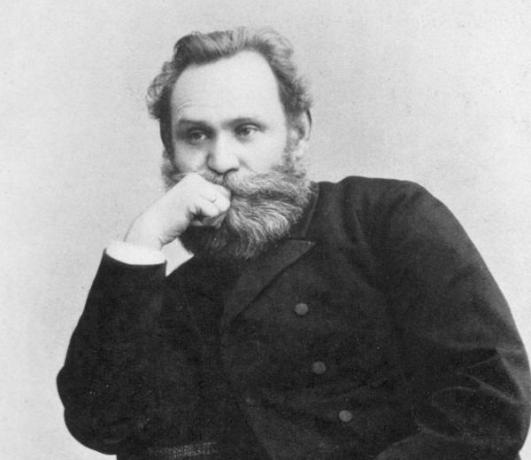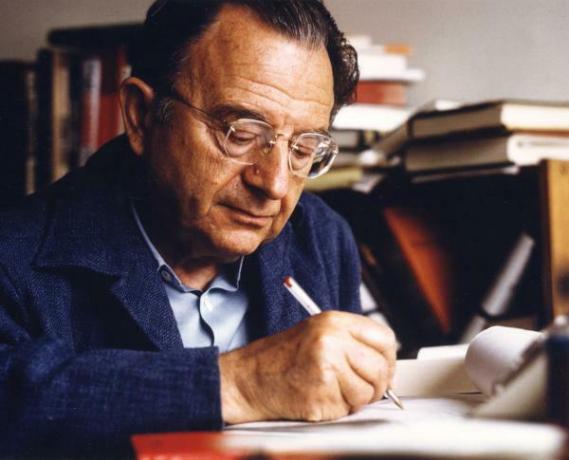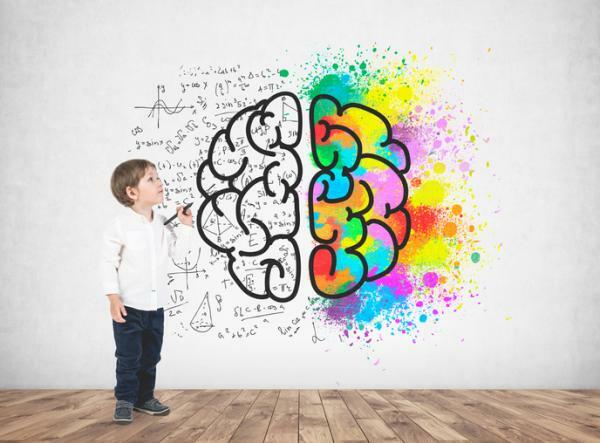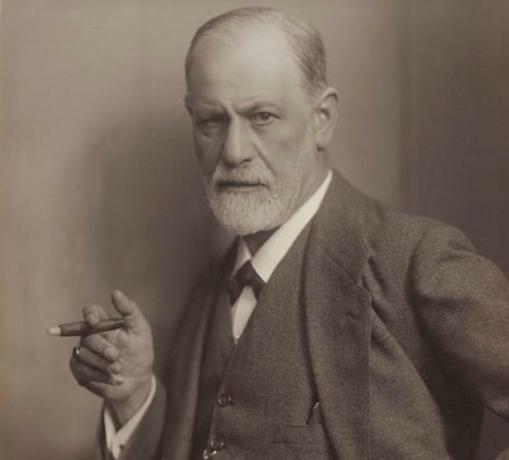
Who was Sigmund Freud? Sigmund Freud is the most famous psychiatrist and a great researcher in the field of the human mind. He was a neurologist, of Austrian and Jewish origin. Freud dared with innovative theories based on sexuality, unraveling the mystery of neuroses and relating them to sexual trauma. He is the author who gave meaning to terms of such caliber as repression, unconscious or superego.
Currently, Sigmund Freud is considered the father of psychoanalysis and one of the most influential figures in contemporary thought. If you want to know who Sigmund Freud was and what he represents for psychology, keep reading this article Sigmund Freud: biography and his theory of psychoanalysis. Where we will see the most important events in his life and his contributions to psychology. Shall we take a walk through the interesting biography of Sigmund Freud? Go!
The beginning of the history of Sigmund Freud
The history of Sigmund Freud begins with Dr. Joseph Breuer, one of Freud's great influences. Breuer had a patient, Anna O., who was the primary caregiver for his sick father for much of his life. When his father, Anna O. he started showing a series of
Eleven years later, Breuer and his assistant, Freud, turned their theory of hysteria into a book. The theory explained that hysteria was considered the result of trauma that it could not be accepted by the person who had suffered it. The emotions that this traumatic situation would unleash were repressed and expressed through behavioral or physical symptoms. In such cases, when the patient came to understand and accept the trauma and origin of the symptoms, they disappeared.
Patient Anna O. she was gradually improving her symptoms with Breuer's treatment, but the patient seemed to be falling in love with him. So, for personal reasons, Breuer had to stop treatment. Later, Freud got to the bottom of the matter by openly postulating that behind the hysterical neuroses there was a sexual desire.
Biography of Sigmund Freud
Sigmund Freud was born on May 6, 1856 in Freiberg, a German city. Son of a wool merchant and a vivacious 21-year-old girl. He had 2 stepbrothers on his father's side and 6 other siblings. His parents had an age difference of 20 years. Freud received a traditional Jewish education, although he was not a practicing Jew.
In 1860, when Freud was about 3 years old, his family moved to Leipzig and a year later moved to Vienna, city in which Freud would stay practically all his life. His parents went through bad economic times, but they always worried about their son's education.
Sigmund Freud was a good student who in 1873, aged 17, got a place in medical school from the University of Vienna. Something that was not so simple, at the time, for a young Jew in the capital of Austria.
At the Ernst von Brücke Institute of Physiology in 1882, he became passionate about physiology and research with his teacher, who believed that the functioning of the organism could be explained by the forces physicochemical. Freud was very good at researching neurophysiology, he was even one of the pioneers in postulating the therapeutic use of cocaine. His professor, Brücke, helped him obtain a scholarship to study with the psychiatrist Charcot at the Salpêtriere hospital in Paris and with Bernheim in Nancy. Who were two great scientists who investigated hypnosis as a treatment for patients with hysteria. This marks the biography of Sigmund Freud.
After completing his training as a neurology resident, Freud returned to Vienna. In 1882, he began work at the Vienna General Hospital. Later, in 1886, opened his own neuropsychiatry practice with the help of Joseph Breuer. He began to treat hysteria through hypnosis and catharsis, just as he had learned from his mentor Breuer in treating Anna O. That same year, he married his fiancee Marta Bernays. With her he had 5 children, including Anna Freud.
In 1889 he attended the First International Congress of Hypnotism. Freud was increasingly focused on "diseases of the nerves" and self-analysis.
Between 1895 and 1900, Freud abandoned hypnosis and catharsis and developed a new technique: free association. This technique consisted of encouraging patients to verbalize any product of the mind, without censorship. With it, the symptoms of patients with hysteria improved.
Another of the most important events in Sigmund Freud's biography was in 1899, when one of his most relevant works was published: The interpretation of dreams. Thus initiating a theoretical and practical discipline around the human mind: psychoanalysis.
In 1902, he obtained his extraordinary teaching title and recognition as the creator of psychoanalysis. He earned a reputation as a curator of hysteria. The weekly meetings of the Psychological Society also began, where intellectuals met to share ideas. Sigmund Freud was invited by G. Stanley Hall in 1908 to the United States with the objective that Freud offered a series of conferences to disseminate psychoanalysis.
Freud, with his work and works, acquired fame and many followers, who would later form the psychoanalytic movement. Freud rejected those who did not agree with his theories, establishing rivalry between different schools of thought. Freud was a methodical and rigid man in terms of his customs, he liked to eat at 1 o'clock, go for a walk and visit the Historical Museum of Art.
Freud developed maxillobucal cancer, which is why he was operated on up to 33 times. This disease caused him hearing difficulties and impaired his ability to speak. However, he continued to work and write throughout his life.
Vienna was a Catholic city, so Freud's theories about sexuality were a great scandal. However, that was not what prompted him to leave just before World War II, but the little security that Vienna offered for Jews. It was then that Freud, convinced thanks to Marie Bonaparte, emigrated to England, settling in London.
Sigmund Freud died in London on September 23, 1939 cancer that had been diagnosed in 1923. His legacy lives on today.
Anna Freud, his daughter, continued his studies and his theories on child psychology. Anna Freud was a renowned psychoanalyst, especially in the field of psychological development.
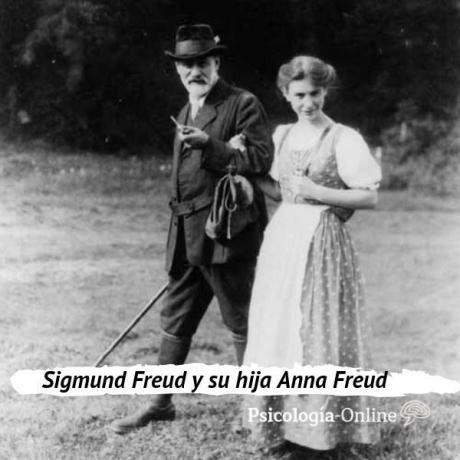
Sigmund Freud is known as the founder of psychoanalysis, a current of psychology.
What is psychoanalysis
Psychoanalysis is a stream of psychology that is based on theories about the human mind. This theory offers a model of the mind and a therapy based on that model. Psychoanalysis starts from the idea that we have a large part of the mind that is unconscious and continues with the parts of identity (I, It and Superego).
Currently, psychoanalysis is not part of the branches of scientific psychology. It has been widely refuted, since lacks scientific validation.
Freud's psychoanalytic method
Sigmund Freud developed the psychoanalytic method, which consists in provoking the liberation from the repressed so that you can go to consciousness. The main procedure of Freud's psychoanalytic method is the method of free associations. This method is based on the idea that psychic activity is influenced by unconscious and preconscious impulses. It consists of letting the mind wander freely and explaining everything that comes to consciousness. The goal is to make disturbing unconscious facts that are the cause of the discomfort conscious.
Another procedure of Freud's psychoanalytic method is the study of failed acts. This consists of taking into account and interpreting failed acts, which are unforeseen acts that escape conscious control. Examples of failed acts are mistakes in speech, reading, or writing.
Another procedure is dream interpretation. According to Freud, dreams symbolically reveal instinctual drives, repressed or unsatisfied unconscious desires.
Sigmund Freud popularized the conscious and unconscious concepts, understanding the mind aware as one who is aware of her thoughts, while the mind unconscious, the largest part, is the one that includes everything that is not accessible to consciousness, such as instincts, impulses or traumas. There is also the preconscious, what we are able to remember, that is, what we can bring to consciousness.
The psychological unconscious is the starting point of Freud's theory. According to him, the content of the unconscious mind is the origin of our motivations, motivations that we have a tendency to deny or resist. This is where censorship, acquired through education, comes into play. These impulses and motivations of the unconscious appear in disguise. The 3 forces (conscious, unconscious and censorship) have dynamic relationships. Personality depends on the combination between them.
The id, the ego and the superego
First, the It. The It, for Sigmund Freud, is the body and the nervous system, destined to satisfy our needs such as hunger, thirst, sex and the avoidance of pain. The It translates the needs of the body into motivations, for Freud, the drives or desires. The transformation from need to desire is called the primary process. The purpose of the id is to preserve the pleasure principle, that is, to meet biological needs. For Freud, a baby is practically It. The It is composed of instincts and the repressed, these influence thought and behavior. When a need is not satisfied, for example, we are hungry, it begins to attract more and more attention. That would be the desire breaking into consciousness.
In second place, The I. The I is the conscious part. This part emerges from the Id and is shaped by the influence of the outside world. The Self is a more rational part that acts as intermediary between the id and the outside world. It allows stopping the impulses of the Id and responding to the demands of the environment. According to Sigmund Freud, the Ego is governed by the reality principle, which aims to adapt the behavior of the person to the environment. The Ego decides whether or not it satisfies the impulses of the Id. When the I does not satisfy the impulses of the id, repression is generated.
By last, the superego. The superego is formed by the influence of parents and other educators. It is the moral aspect that takes into account requirements and standards internalized during education. The superego is the moral conscience and its function is to repress impulses that do not correspond with ethical principles.
Freud's theory of personality says that the personality corresponds to the ego and arises from the claims of the id and the repression of the superego.
Defense mechanisms
Defense mechanisms, according to Freud's psychoanalytic theory, are inconsistent strategies that they serve to avoid, deny or distort anxiety-producing thoughts. Freud proposed various defense mechanisms, such as: denial, repression, reaction formation, regression, projection, rationalization, compensation and sublimation.
The drives in Freud's theory
The drives, in Freud's theory, are the tensions due to the needs of the Id that exert pressure for action. Distinguish two basic and opposite instincts:
- Eros, the life drive or love instinct. This drive aims to guarantee survival, generate unions and satisfy needs. Seek pleasure and get gratification.
- Thanatos, death drive or destruction instinct. This drive represents the unconscious desire for death, regression and disintegration.
Freud's psychosexual theory
According to Sigmund Freud, the sexual factors are decisive. With his studies, he found that the sexual was of great importance. For this reason, psychosexual development is a central element of Freud's theory.
Freud's psychosexual theory holds that instincts produce a psychological energy that he calls libido and that this libido develops during 5 stages. Freud's stages are as follows:
- Oral stage. From birth to the first year, the focus of satisfaction is in the mouth. Pleasure is obtained through suction. If there is little or too much gratification of this desire, a psychological fixation can occur that would give rise to a personality with passive, credulous, immature and pessimistic traits.
- Anal stage. From 18 months to 3 years, pleasure is found in the anus. Pleasure is obtained by expelling and retaining stool. Strict toilet training can influence the personality of a child with self-destructive and self-defeating traits.
- Phallic stage. From 3 to 6 years, the genitals begin to be discovered. It is at this stage that the Oedipus complex and the Electra complex. If the gratification is not enough, personality traits such as selfishness, vanity, and shyness can develop.
- Latency stage. From 6 to 12 years old, interest in sexuality is lost and previously developed personality traits are consolidated.
- Genital stage. From puberty to adulthood, sexual interest is in the erogenous zone.
The repercussions of his research and the importance of his theories are still valid today. In the following article you will find more detailed information about the Freud's stages of psychosexual development.

